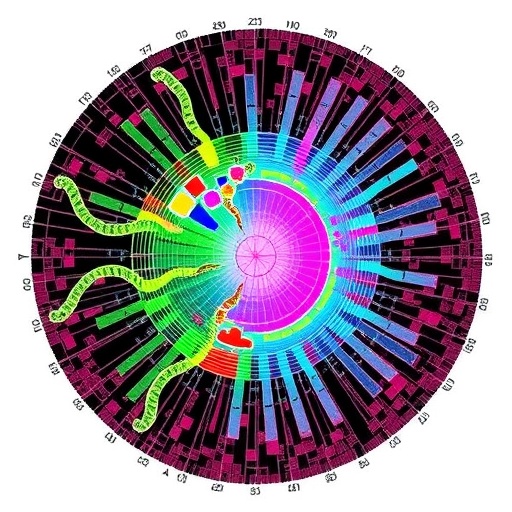In the relentless battle against cancer, understanding the intricate evolutionary dynamics of tumors remains a formidable challenge. A groundbreaking study published recently in Nature shines new light on this issue, unveiling how fluctuating DNA methylation patterns can serve as a sentinel to track cancer evolution on a clinical scale. This innovative approach not only deepens our understanding of tumor heterogeneity but also opens new avenues for precision oncology, marking a leap forward in our ability to monitor and potentially predict cancer progression.
Cancer is not a static disease but an evolving system characterized by the emergence of genetically distinct subpopulations, or subclones. These subclones can possess unique mutations and epigenetic modifications that confer selective advantages, enabling them to thrive amidst therapeutic pressures or immune responses. Traditionally, researchers have focused on genetic sequencing techniques to detect such subclonal architectures; however, limitations in sensitivity—particularly in whole-exome sequencing (WES)—have restricted our capacity to capture these dynamic processes fully.
In this pioneering study, the authors present EVOFLUx, a novel analytical framework that leverages patterns of fluctuating DNA methylation to infer subclonal architectures and evolutionary trajectories within tumors. DNA methylation, a fundamental epigenetic modification influencing gene expression without altering the genetic code, displays distinctive distribution patterns in cellular populations, reflecting the presence of diverse clonal lineages. Through meticulous analysis of these methylation fluctuations, EVOFLUx discerns the evolutionary narrative that genetic data alone may miss.
Applying EVOFLUx across a vast cohort encompassing nearly two thousand tumor samples, the researchers uncovered compelling evidence that most cancers exhibit a monoclonal or effectively neutral evolutionary landscape, with no detectable subclones. Intriguingly, this pattern was not uniform; certain tumor types exhibited markedly higher frequencies of subclonal detection. Chronic lymphocytic leukemia (CLL) stood out, with approximately 30% of cases presenting robust subclonal activity, whereas diffuse large B-cell lymphoma (DLBCL) showed fewer than 5% of tumors with such complexity. This variability underscores the diverse evolutionary pressures and microenvironmental contexts shaping different cancer types.
A critical validation aspect of this study involved juxtaposing EVOFLUx inferences with subclonal detections obtained via MOBSTER, a state-of-the-art tool applied to matched whole-exome and whole-genome sequencing data from CLL patients. While MOBSTER identified subclones in a subset of tumors, its sensitivity was closely tied to the mutational burden, showing diminished detection power in samples with fewer mutations. Conversely, EVOFLUx demonstrated a superior ability to detect ongoing subclonal selection independently of mutation counts, especially when validated against higher-resolution whole-genome sequencing (WGS) data, where agreement between the methods improved significantly.
The implications of these findings are manifold. By harnessing methylation data, EVOFLUx transcends the limitations inherent to mutation-based subclone detection, offering a complementary and arguably more sensitive window into tumor evolution. This is particularly vital in clinical contexts, where early detection of emerging subclones can inform treatment decisions, anticipate resistance, and guide personalized therapeutic strategies.
Further deepening their analysis, the researchers explored clonal origins within CLL samples, identifying cases harboring two or more independent subclones stemming from distinct ancestral cells. This phenomenon, rarely observed in many cancers, was detected in roughly three percent of the cohort. Validation through immunoglobulin gene rearrangement profiling, comparing DNA and RNA sequencing data, confirmed these findings, illustrating that multiple independent clonal origins correspond to unique rearrangement patterns—a hallmark of independent evolutionary trajectories.
Simulations underpinning EVOFLUx’s performance demonstrated that the method is particularly adept at detecting strongly selected subclones that arise at intermediate timepoints during tumor evolution. This temporal nuance is critical, as very recent or ancient subclones often evade detection due to insufficient divergence or dominance within the tumor cell population. These simulation results parallel the intrinsic challenges faced in traditional subclone detection techniques, reinforcing EVOFLUx’s practical applicability and limitations.
The study also reveals that the majority of tumor evolution in the sampled cohort could be classified as effectively neutral, meaning there are no apparent selective pressures driving the expansion of subclones above neutral drift. This insight has profound implications for our understanding of tumor biology, suggesting that many cancers evolve through random mutational processes rather than directional selection, at least during certain evolutionary windows.
EVOFLUx’s reliance on methylation rather than solely genetic alterations allows the investigation of evolutionary dynamics at a scale and resolution that have been previously unattainable. DNA methylation patterns can reflect cellular lineage relationships and epigenetic drift, capturing the subtle interplay between genetics and the tumor microenvironment. By integrating this layer of information, EVOFLUx equips researchers and clinicians with a more holistic view of tumor composition and evolution.
The study’s robust cohort, comprising almost 2,000 tumors from diverse cancer types, alongside extensive validation sets with matched WES and WGS data, underscores the clinical relevance and scalability of the approach. The authors also highlight the potential for EVOFLUx to inform future biomarker development, enabling precision monitoring of tumor evolution, particularly in hematological malignancies like CLL where subclonal dynamics critically impact disease course.
Beyond its immediate clinical applications, this work exemplifies the power of combining epigenomic and genomic data to surmount longstanding challenges in cancer biology. The demonstrated ability to identify independent clonal origins provides a new dimension to tumor phylogenetics, offering insights into the early events of tumorigenesis and intratumoral heterogeneity.
In the broader landscape of cancer research, the integration of fluctuating DNA methylation as a proxy for evolutionary history represents a paradigm shift. It encourages the field to move beyond mutation-centric models and embrace epigenetic fluctuations as informative markers. This dual approach could pave the way for novel diagnostic tools and therapeutic targets that address the complexity of cancer evolution more comprehensively.
As the battle against cancer continues, innovations such as EVOFLUx signify hope for more accurate, timely, and personalized interventions. By unraveling the cryptic evolutionary narratives encoded in methylation patterns, clinicians may soon be equipped to anticipate resistance, adapt treatments dynamically, and ultimately outpace cancer’s relentless adaptability.
Subject of Research: Cancer evolution and subclonal architecture analysis using DNA methylation fluctuations.
Article Title: Fluctuating DNA methylation tracks cancer evolution at clinical scale.
Article References:
Gabbutt, C., Duran-Ferrer, M., Grant, H.E. et al. Fluctuating DNA methylation tracks cancer evolution at clinical scale. Nature (2025). https://doi.org/10.1038/s41586-025-09374-4
Image Credits: AI Generated
Tags: cancer heterogeneity understandingdynamic processes in tumor evolutionepigenetic modifications in tumorsEVOFLUx analytical frameworkfluctuating DNA methylation in cancergenetic sequencing limitations in oncologyinnovative approaches in cancer researchmonitoring cancer progressionprecision oncology advancementspredicting cancer subpopulation emergencesubclonal architecture analysistumor evolution tracking methods





